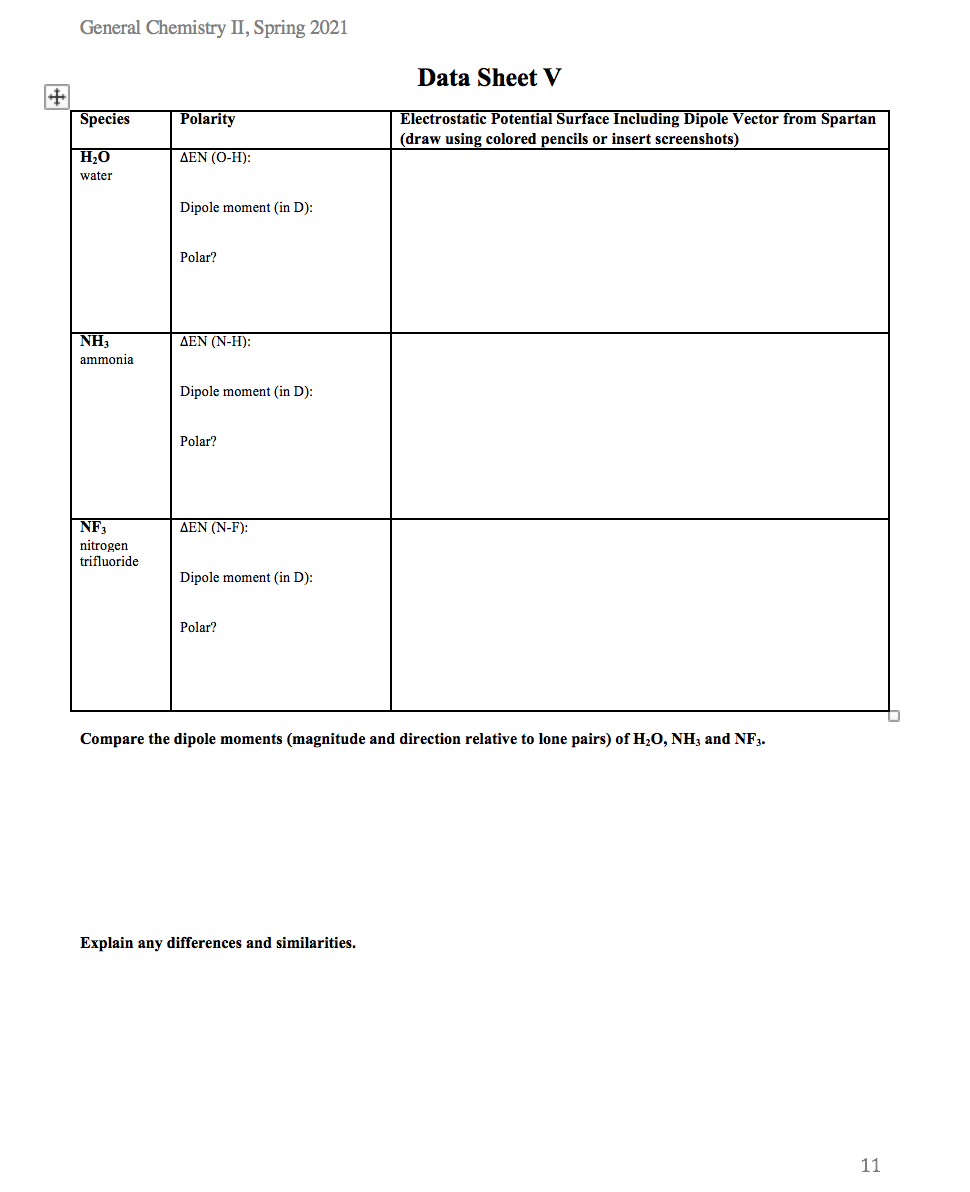Data Sheet V Polarity Electrostatic Potential Surface Including Dipole Vector from Spartan (draw using colored pencils or insert screenshots) Species H,0 ΔΕΝ (Ο-Η): water Dipole moment (in D): Polar? NH, ammonia AEN (N-H): Dipole moment (in D): Polar? NF, AEN (N-F): nitrogen trifluoride Dipole moment (in D): Polar? Compare the dipole moments (magnitude and direction relative to lone pairs) of H¿0, NH3 and NF.
Data Sheet V Polarity Electrostatic Potential Surface Including Dipole Vector from Spartan (draw using colored pencils or insert screenshots) Species H,0 ΔΕΝ (Ο-Η): water Dipole moment (in D): Polar? NH, ammonia AEN (N-H): Dipole moment (in D): Polar? NF, AEN (N-F): nitrogen trifluoride Dipole moment (in D): Polar? Compare the dipole moments (magnitude and direction relative to lone pairs) of H¿0, NH3 and NF.
Organic Chemistry: A Guided Inquiry
2nd Edition
ISBN:9780618974122
Author:Andrei Straumanis
Publisher:Andrei Straumanis
Chapter4: Polar Bonds, Polar Reactions
Section: Chapter Questions
Problem 10CTQ
Related questions
Question

Transcribed Image Text:General Chemistry II, Spring 2021
Data Sheet V
Species
Polarity
Electrostatic Potential Surface Including Dipole Vector from Spartan
(draw using colored pencils or insert screenshots)
H20
ΔΕΝ (Ο-Η):
water
Dipole moment (in D):
Polar?
NH3
ΔΕΝ (N-Η):
ammonia
Dipole moment (in D):
Polar?
NF3
ΔΕΝ (N-F) :
nitrogen
trifluoride
Dipole moment (in D):
Polar?
Compare the dipole moments (magnitude and direction relative to lone pairs) of H;O, NH3 and NF3.
Explain any differences and similarities.
11
Expert Solution
Step 1 Analysis
Given: Three molecules H2O, NH3 and NF3
To find: To write about polarity, electronegativity, dipole moment and to draw the vectors.
Solution: Electronegativity means the tendency of the more electronegative atom to attract the electrons towards itself. Dipole moment means the separation of the charges, the more electronegative atom will get partially negative charge and the less electronegative atom will get the positive charge.
If there is difference between the electronegativity of the two atoms then the bond will be polar and the molecule is said to be polar molecule.
Step by step
Solved in 2 steps with 1 images

Knowledge Booster
Learn more about
Need a deep-dive on the concept behind this application? Look no further. Learn more about this topic, chemistry and related others by exploring similar questions and additional content below.Recommended textbooks for you

Organic Chemistry: A Guided Inquiry
Chemistry
ISBN:
9780618974122
Author:
Andrei Straumanis
Publisher:
Cengage Learning

General Chemistry - Standalone book (MindTap Cour…
Chemistry
ISBN:
9781305580343
Author:
Steven D. Gammon, Ebbing, Darrell Ebbing, Steven D., Darrell; Gammon, Darrell Ebbing; Steven D. Gammon, Darrell D.; Gammon, Ebbing; Steven D. Gammon; Darrell
Publisher:
Cengage Learning

Chemistry by OpenStax (2015-05-04)
Chemistry
ISBN:
9781938168390
Author:
Klaus Theopold, Richard H Langley, Paul Flowers, William R. Robinson, Mark Blaser
Publisher:
OpenStax

Organic Chemistry: A Guided Inquiry
Chemistry
ISBN:
9780618974122
Author:
Andrei Straumanis
Publisher:
Cengage Learning

General Chemistry - Standalone book (MindTap Cour…
Chemistry
ISBN:
9781305580343
Author:
Steven D. Gammon, Ebbing, Darrell Ebbing, Steven D., Darrell; Gammon, Darrell Ebbing; Steven D. Gammon, Darrell D.; Gammon, Ebbing; Steven D. Gammon; Darrell
Publisher:
Cengage Learning

Chemistry by OpenStax (2015-05-04)
Chemistry
ISBN:
9781938168390
Author:
Klaus Theopold, Richard H Langley, Paul Flowers, William R. Robinson, Mark Blaser
Publisher:
OpenStax


Chemistry: The Molecular Science
Chemistry
ISBN:
9781285199047
Author:
John W. Moore, Conrad L. Stanitski
Publisher:
Cengage Learning